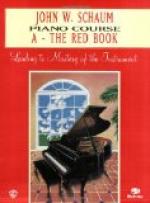Of the Clavier Stuecke, Op. 76, Von Buelow said: “The Capriccio, No. 1 must not be taken too fast. First page is merely a prelude, the story begins at the second page. How wonderfully is this melody formed, so original yet so regular. Compare it with a Bach gigue. Remember, andante does not mean dragging (schleppando), it means going (gehend).” To the player who gave the Capriccio, No. 5 he said: “You play that as if it were a Tarantelle of Stephan Heller’s. Agitation in piano playing must be carefully thought out; the natural sort will not do at all. We do not want blind agitation, but seeing agitation (aufregung). A diminuendo of several measures should be divided into stations, one each for F, MF, M, P, and PP. Visit the Zoological Gardens, where you can learn much about legato and staccato from the kangaroos.”
The Ballades were taken up in these lessons, and the light thrown upon their poetical content was often a revelation. The gloomy character of the Edward Ballade, Op. 10, No. 1, the source of the Scottish poem, the poetic story, were dwelt upon. The opening of this first Ballade is sad, sinister and mysterious, like the old Scotch story. The master insisted on great smoothness in playing it—the chords to sound like muffled but throbbing heartbeats. A strong climax is worked up on the second page, which dies away on the third to a pianissimo of utter despair. From the middle of this page on to the end, the descending chords and octaves were likened to ghostly footsteps, while the broken triplets in the left hand accompaniment seem to indicate drops of blood.
The third Ballade also received an illumination from Von Buelow. This is a vivid tone picture, though without motto or verse. Starting with those fateful fifths in the bass, it moves over two pages fitfully gloomy and gay, till at the end of the second page a descending passage leads to three chords so full of grim despair as to impart the atmosphere of a dungeon. The player was hastily turning the leaf. “Stop!” cried the excited voice of the master, who had been pacing restlessly up and down, and now hurried from the end of the salon. “Wait! We have been in prison—but now a ray of sunshine pierces the darkness. You must always pause here to make the contrast more impressive. There is more music in this little piece than in whole symphonies by some of the modern composers.”
Both Rhapsodies Op. 79 were played; the second, he said, has parts as passionate as anything in the Goetterdammerung. Both are fine and interesting works.
Again and again the players were counseled to make everything sound well. Some intervals, fourths for instance, are harsh; make them as mild as possible. For one can play correctly, but horribly! Some staccatos should be shaken out of the sleeve as it were.
The first time a great work is heard there is so much to occupy the attention that only a small amount of pleasure can be derived from it. At the second hearing things are easier and by the twelfth time one’s pleasure is complete. The pianist must consider the listener in a first rendering, and endeavor to soften the sharp discords.




